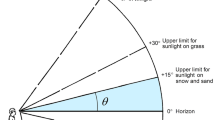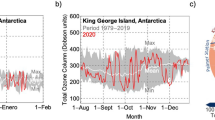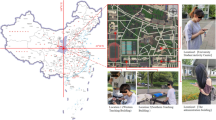Abstract
The solar-UV exposures of school pupils and medical undergraduates were studied over four seasons in Shenyang (latitude 41°11′–43°2′, longitude 122°25′–123°48′), Liaoning, PR China. Ultraviolet exposure was measured using personal ultraviolet radiation (UVR) sensor on sunny days along with simultaneous monitoring and recording of direct-ambient UVR dose (perpendicular UV dose) for comparison. We observed that the UV doses of pupils on weekdays were higher than those on weekends and that the UV doses of the pupils were significantly higher than those of the undergraduates during both weekdays and weekends. The percent of the mean individual daily UV dose to the environmental counterpart are 2.88% (Autumn), 7.76% (Winter), 3.77% (Spring) and 2.06% (Summer) for the pupils, and corresponding percent for the undergraduates are 0.88%, 0.32%, 0.67% and 0.81%. The means of minimum erythemal dose values with pupils for weekday (5 days), weekend (2 days) and week (7 days) through the whole year are 0.302 (0.275∼0.328), 0.215 (0.170∼0.261) and 0.278 (0.255∼0.301), respectively. The corresponding means with undergraduates are 0.097 (0.081∼0.113), 0.091 (0.070∼0.112) and 0.095 (0.082∼0.108), respectively. Although the season is a major factor influencing the personal direct-ambient percent, it is emphasized that the impact of the lifestyle cannot be ignored.
This is a preview of subscription content, access via your institution
Access options
Subscribe to this journal
Receive 6 print issues and online access
$259.00 per year
only $43.17 per issue
Buy this article
- Purchase on Springer Link
- Instant access to full article PDF
Prices may be subject to local taxes which are calculated during checkout








Similar content being viewed by others
Abbreviations
- MED:
-
minimum erythemal dose
- NBS:
-
National Bureau of Standards
- UV-A:
-
UV radiation of wavelengths 315–400 nm
- UV-B:
-
UV radiation of wavelengths 280–315 nm
- UVR:
-
ultraviolet radiation.
References
Cruickshanks K.J., Klein R., and Klein A.R.E. Sunlight and age-related macular degeneration: the Beaver Dam Eye Study. Arch Ophthalmol 1993: 111: 514–518.
Dandona L., Dandona R., Naduvilath T.J., McCarty C.A., Srinivas M., Mandal P. et al. Burden of moderate visual impairment in an urban population in southern India. Ophthalmology 1999: 106: 497–504.
Diffey B.L., Gibson C.J., Haylock R., and McKinlay A.F. Outdoor ultraviolet exposure of children and adolescents. Br J Dermal 1996: 134: 1030–1034.
Gies P., Roy C., Toomey S., MacLennan R., and Watson M. Solar UVR exposure of primary school children at three location in Queens land. Photochem Photobiol 1998: 68: 78–83.
Godar D.E UV doses of American children and adolescents. Photochem Photobiol 2001: 74: 787–793.
Godar D.E., Wengraitis S.P., Shreffler J., and Sliney D.H . UV doses of Americans. Photochem Photobiol 2001: 73: 621–629.
Gruijil F.R., and Leun J.C . Estimate of the wavelength dependency of ultraviolet carcino genesis in humans and its relevance to the risk assessment of stratospheric ozone deletion. Health Phys 1994: 67: 319–325.
Hiller R., Giacometti L., and Yuen K . Sunlight and cataract: an epidemiologic investigation. Am J Epidemiol 1977: 105: 450–459.
Hiller R., Sperduto R.D., and Ederer F . Epidemiological associations with cataract in the 1971–1972 national health and nutrition examination survey. Am J Epidemiol 1983: 118: 239–249.
Jankowskj J., and Cader A.B . The effect of depletion of the earth zone layer on the human health condition. Int J Occup Med Environ Health 1997: 10: 349–364.
Munakata N., Ono M., and Watanabe S . Monitoring of solar UV exposure among schoolchildren in five Japanese cities using spore dosimeter and UV-coloring labels. Jpn J Cancer Res 1998: 89: 235–245.
Ono M . Preliminary study on exposure measurement of ultraviolet radiation. Dev Ophthalmol 1997: 27: 81–88.
Ribert C., and Dubertret L . Cancers of the skin, relations to ultraviolet rays. Press Med 1995: 24: 1610–1616.
Sasaki K., Sasaki H., Kojima M., Shui Y.B., Hockwin O., Jonasson F. et al. Epidemiological studies on UV-related cataract in climatically different countries. J Epidemiol 1999: 9: S33–S38.
Sasaki K., Ono M., Aoki K., Katou N., Morine M., Nakaizumi H. et al. Cataract epidemiology survey in the three different areas in Japan — prevalence of cataracts and types of lens pacification. J Jpn Ophthalmol Soc 1995: 99: 204–211.
Soehnge H., Ouhtit A., and Ananthaswamy O.N . Mechanisms of induction of skin cancer by UV radiation. Front Biosci 1997: 2: 538–551.
United Nations Environment Program. Environmental Effects of Ozone Depletion: 1998 Assessment. Nairobi, Kenya, 1998.
United Nations Environment Program. Environmental Effects of Ozone Depletion and its Interactions with Climate Change: 2002 Assessment. Nairobi, Kenya, 2002.
Vajpayee R.B., Joshi S., Saxena R., and Gupta S.K . Epidemiology of cataract in India: combating plans and strategies. Ophthalmic Res 1999: 31: 86–92.
West S.K., Longstreth J.D., Munoz B.E., Pitcher H.M., and Duncan D.D . Model of risk of cortical cataract in the US population with exposure to increased ultraviolet radiation due to stratospheric ozone depletion. Am J Epidemiol 2005: 162: 1080–1088.
World Health Organization. Ultraviolet Radiation Environment Health Criteria., 160, Geneva, 1994.
Yamazaki C., Hayashi M., Nakayama T., and Arai S . Development and application of a new solar UV radiation sensor for personal use. Nippon Koushouhin Kagaku Kaishi 1990: 14: 190–195.
Zhang S.Y . Date analysis on epidemiologic survey of cataract in China. Chin J Ophthamol 1999: 35: 336–340.
Acknowledgements
This work has been supported by the National Natural Science Foundation of China 40275036. We are grateful for anonymous reviewers, as well as Professor Ge Wang and Deepak Bharkhada, for their important comments and editorial help.
Author information
Authors and Affiliations
Corresponding author
Rights and permissions
About this article
Cite this article
Liu, Y., Ono, M., Yu, D. et al. Individual solar-UV doses of pupils and undergraduates in China. J Expo Sci Environ Epidemiol 16, 531–537 (2006). https://doi.org/10.1038/sj.jes.7500492
Received:
Accepted:
Published:
Issue Date:
DOI: https://doi.org/10.1038/sj.jes.7500492
Keywords
This article is cited by
-
Personal ultraviolet Radiation exposure in a cohort of Chinese mother and child pairs: the Chinese families and children study
BMC Public Health (2019)
-
Sun exposure and 25-hydroxyvitamin D3 levels in a community sample: Quantifying the association with electronic dosimeters
Journal of Exposure Science & Environmental Epidemiology (2017)



